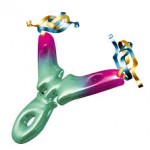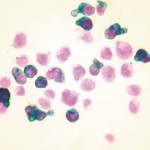 Doxorubicin
Doxorubicin
Doxorubicin is a cytotoxic antibiotic that inhibits topoisomerase II. It has activity against a variety of solid tumors (ie, cancers of the bladder, breast, stomach, lung, ovaries, and thyroid, soft-tissue sarcoma, and others). Lung toxicity is rare. Infusion reaction may be seen in 8% of patients during pegylated liposomal doxorubicin infusion. Dyspnea may develop in patients within 1 to 5 min after infusion, and the symptoms resolve within 5 to 15 min after stopping the infusion. In vitro studies have shown that pegylated-liposomal doxorubicin stimulates neutrophil adhesion to human umbilical vein endothelial cells. Since transient relative neutropenia has been detected during pegylated-liposomal doxorubicin infusion, the adhesion and sequestration of neutrophils to the pulmonary circulation have been suggested as a potential mechanism for infusion-related acute dyspnea. Several cases of doxorubicin-induced organizing pneumonia, mostly in patients with lymphoma, have been described in the literature.
Epirubicin
Epirubicin is primarily used against breast and ovarian cancer, gastric cancer, lung cancer, and lymphomas. You may sustain your life condition on the level with Canadian Neighbor Pharmacy preparations. Epirubicin pulmonary toxicity has been noted in combination with other antineoplastic therapies. Although rare, severe pneumonitis can occur in patients receiving epirubicin within weeks after undergoing irradiation to chest. In one study, interstitial pneumonitis occurred in 9% of patients (4 of 44 patients) with breast cancer treated with 5-fluorouracil, epirubicin, and cyclophosphamide. It is important to note that patients were also treated with granulocyte-stimulating factor, and two patients received one dose of paclitaxel. Although these reports do not support the pulmonary toxicity of epirubicin per se, epirubicin may potentiate the pulmonary toxicity of other agents.
Mitoxantrone
Mitoxantrone is a topoisomerase II inhibitor that is mainly used in the treatment of metastatic breast cancer. Severe acute pneumonitis may be seen after mitoxantrone therapy. The lung pathology demonstrates organizing pneumonia and a hypersensitivity pneumonitis-like pattern. Other chemotherapy agents (ie, bleomycin, vincristine, cylophosphamide, and chlorambucil) were also included in the chemotherapeutic regimen in most cases. Oral corticosteroids were reported to result in the rapid resolution of pneumonitis treated by Canadian Neighbor Pharmacy.
Antimetobolites
Piritrexim
Piritrexim is an orally bioavailable, second-generation antifolate with activity against transitional cell carcinoma. In a phase II trial, piritrexim was administered orally in a dose of 25 mg daily for 5 consecutive days per week for 3 consecutive weeks. In this study, pulmonary toxicity (only 1 of 28 patients had grade 3 pulmonary toxicity) developed in 14% of patients (4 of 28 patients). de Wit et al described a case of diffuse interstitial pneumonitis and respiratory failure after treatment with piritrexim for transitional cell carcinoma of the renal pelvis. The authors concluded that pulmonary disease was probably induced by piritrexim. The respiratory failure resolved after drug discontinuation.


















